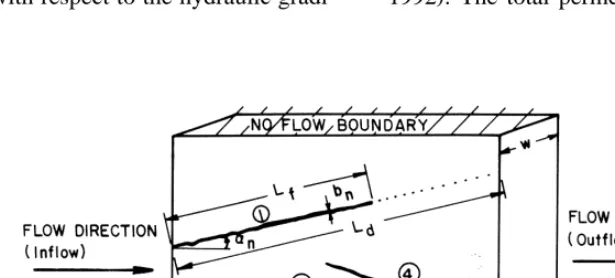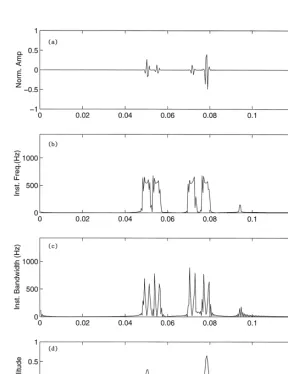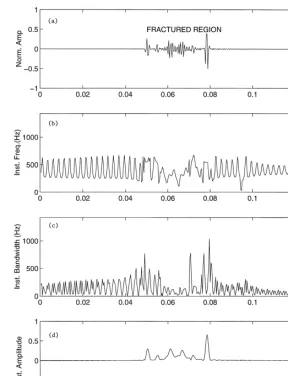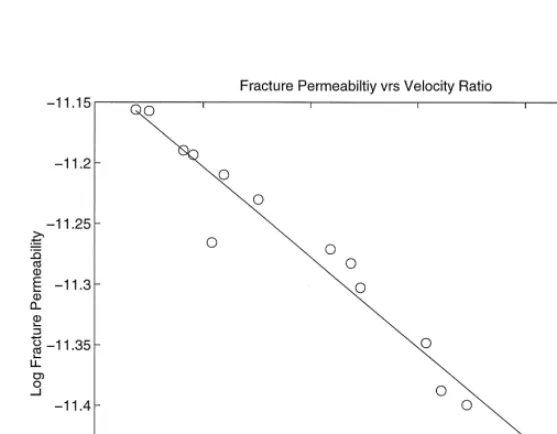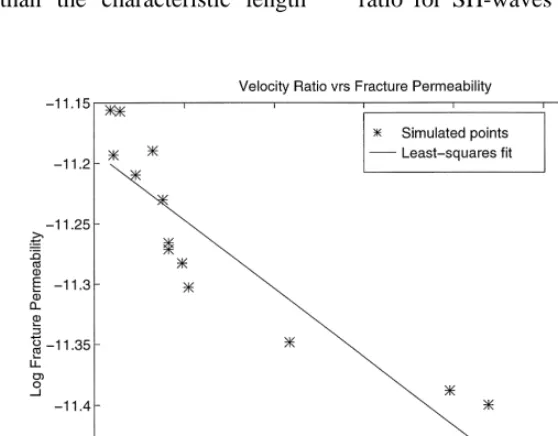www.elsevier.nlrlocaterjappgeo
Predicting the transport properties of fractured rocks from seismic
information: numerical experiments
Fred Kofi Boadu
)Department of CiÕil and EnÕironmental Engineering, Duke UniÕersity, P.O. Box 90287, Durham, NC 27708-0287, USA
Received 15 June 1998; accepted 21 May 1999
Abstract
The hydraulic properties including porosity and permeability of fractured rock masses are estimated from seismic velocities derived from controlled numerical experiments. Models of fractured media are developed to represent fractures embedded in an otherwise intact rock. Fracture porosity and permeability are computed using a hydraulic model that accounts for fracture length, aperture and orientation. Seismic attributes are used as a guide to detect the onset of reflections from the fractured medium. Seismic velocities of the fractured layers are computed from the transit times of seismic waves propagating through the layer. The study shows that the velocity ratio between the fractured and the intact rock correlates with the hydraulic properties. Low velocity ratios are associated with high fracture porosity and permeability. Empirical least-squares regression relationships are developed to describe the correlations for practical use.q2000 Elsevier Science
B.V. All rights reserved.
Keywords: Fractured medium; Seismic velocities; Porosity; Permeability
1. Introduction
Most rocks in the earth’s crust are fractured to some extent in response to tectonic and other in situ stresses. These fractures are pervasive and range in size from microcracks to crustal faults. In civil engineering, geotechnical, hydro-geological and geo-environmental practice, frac-tures play a central role. They enhance porosity and permeability and thereby increase the
reten-) Tel.: q1-919-660-5432; fax: q1-919-660-5219; E-mail: [email protected]
tional and production capabilities of a reservoir or an aquifer. Fractures can control the transport of contaminants in the subsurface and therefore characterizing them is vital in remediation strategies. Retentional and fluid flow properties of fractured aquifers are of enormous concern in remediation efforts. The stability of the founda-tion of engineered structures and excavafounda-tions are degraded when fractures are present in the subsurface. Fractured reservoirs with large re-serves of hydrocarbons exist throughout the
Ž .
world Van Golf-Racht, 1982 . Thus, presently in the hydrocarbon and environmental industry, fracture-related fluid flow imposes increasing challenges to reservoir and site characterization.
0926-9851r00r$ - see front matterq2000 Elsevier Science B.V. All rights reserved.
Ž .
Oil exploration and exploitation efforts are in recent times being redirected toward fractured reservoirs. Though the transport properties and the productive capabilities of fluid filled reser-voirs are undoubtedly influenced by fractures, quantification of fracture systems remains a formidable task. The hydraulic properties are normally measured through localized and ex-pensive operations such as borehole drilling and fluid flow experiments. It is of utmost impor-tance to develop cost-effective techniques to characterize fractures quantitatively, and relate these characteristics to the production capabili-ties of the reservoir.
An important question that often arises and remains unsolved is: How can fractures that are significant in controlling the transport or reten-tion of fluids in the subsurface be identified, located and characterized? A relatively inexpen-sive way to characterize a fractured reservoir remotely and on a much larger volume or scale is through the use of geophysics specifically seismic methods. The question addressed here is: Can we relate the non-invasively and easily measured seismic parameters to hydraulic prop-erties of fractured media? Information about fracture porosity and permeability obtained re-motely would be particularly useful to engineers and hydrogeologists involved in assessment of production and transport potential of aquifers and development of remediation strategies. It would be an important development if informa-tion about the transport properties of a fractured reservoir can be obtained from seismic data. The same parameters that contribute to the vari-ations in hydraulic properties such as effective permeability or discharge also contribute to the variations in seismic velocity and attenuation
ŽCook, 1992 ..
The elastic and hydraulic parameters as well as the travel times and amplitudes of seismic waveforms propagating through such fractured
Ž
medium are modified Walsh and Grosenbaugh, 1974; Goodman, 1976; Brown and Scholz,
.
1986 . Generally, the effect of fractures on seis-mic wave velocities is modeled by deriving the
effective elastic moduli of the fractured rock mass and subsequently relating these moduli to the velocities via the elastodynamic equations. For relatively large, sparsely distributed frac-tures, the effective moduli approach to
calculat-Ž
ing velocities may not be appropriate
Pyrak-.
Nolte et al., 1990 . Furthermore, this approach cannot account for the effect of fractures on seismic wave attenuation. For seismic measure-ments to be useful in characterizing the mechan-ical and transport properties, a physmechan-ical model that describes the geometric properties of the fracture which incorporates the dynamics of the fracture upon interaction with a seismic wave is needed.
An alternative, more versatile model, for de-scribing the effect fractures have on both seis-mic velocity and attenuation is the displacement discontinuity model. The basic premise of this model is that the displacement of seismic waves that propagate across a fracture becomes discon-tinuous while the stresses are condiscon-tinuous. The displacement discontinuity concept is originally
Ž .
due to Mindlin 1960 and first applied to
seis-Ž .
mic wave propagation by Schoenberg 1980 . Several experimental studies have confirmed this
Ž
model Lutsh, 1959; Morris et al., 1964; Pyrak-Nolte et al., 1987; Pyrak-Pyrak-Nolte et al., 1990;
.
Cook, 1992 . The modified displacement
dis-Ž .
continuity model MDD developed by Boadu
Ž1997a; b and Boadu and Long 1996 includes. Ž .
the fracture size, fraction of surface area in contact, viscosity of infilling material and the fracture aperture. This advancement is achieved by incorporating the dynamics of the fracture into the equations of motion and exploiting the analogy between electrical properties and me-chanical properties to obtain the reflection
Žscattering and transmission coefficients. The.
MDD model has been substantiated with experi-mental data and compared with existing models
Ž . Ž .
experi-ments would provide the theoretical base neces-sary for field scale interpretation of relations between seismic and hydraulic parameters.
2. Theoretical formulations
For two half spaces bounded by rough sur-faces that are partly in contact with one another, the boundary conditions for an incident wave are
where tp and ts are the respective normal and tangential stresses, ep and es are normal and tangential strain, r is the radius vector determin-ing the plane of the fracture in space and Zm is the fracture impedance. The magnitude of the ‘jump’ in the discontinuity of the displacement is determined by the fracture impedance Z ,m
where Zp is the longitudinal wave impedance
and Z is the transverse wave impedance.s
The impedance of the fracture is obtained by exploiting the well-established analogies
be-tween mechanical and electrical quantities
ŽAnderson, 1985 . The existence of formal rela-.
tions between equations for acoustical wave motion and electric transmission lines allows us to treat the fracture as a transmission line for passage of seismic waves. The corresponding equations of motion have been developed and solved for the transmission and reflection
coef-Ž
ficients for an incident P-wave Boadu, 1997a,b;
.
Boadu and Long, 1996 . The ratio of the impedance of intact rock and that of the fracture is termed the inhomogeneity factor jm. This is an important parameter which greatly affects the seismic wave response. It is a function of the
acoustic impedance of intact rock, fracture length and opening, viscosity of infilling mate-rial, and fraction of fracture surface area in contact, and the frequency of the seismic wave
ŽBoadu, 1997a,b; Boadu and Long, 1996 ..
For an incident longitudinal wave at an angle
u to the plane of the fracture, the complex
reflection and transmission coefficients have been found to be:
f jpp p f jps s of the angle of incidence and the Poisson’s ratio
Ž
of the intact material Boadu, 1997a,b; Boadu
.
and Long, 1996 . For SH-waves, the expres-sions for the reflection and transmission coeffi-cients are
The geometric characteristics of the fracture affect the reflection and transmission coeffi-cients which are also frequency dependent. The amplitude and phase of a waveform propagating across a single fracture have been shown to
Ž
change significantly Boadu, 1997a,b; Boadu
.
un-dergo the least change. In the reflected waves however, the high frequencies dominate.
Ž .
The method described in Boadu 1997a will be used in this study to obtain synthetic
seismo-Ž .
grams from the global reflection coefficient R for a stack of layers including a fractured medium with fractally distributed fracture pa-rameters. Synthetic seismograms that include reflections from the fractured layer are then computed using reflectivity methods. The ap-proach involves integration of reflection and
transmission coefficients for unfractured
Žwelded. and fractured Žunwelded. interfaces into a recursive scheme, from which the hy-bridized global reflection and transmission coef-ficients are computed. This methodology can also account for the absorptive properties of the intact rock. Any realistic modeling of fluid transport in fractured terrain or estimation of its strength properties has to take into account such
Ž
distribution properties Boadu and Long,
.
1994a,b . In the numerical experiments de-scribed in this paper, fractal fracture lengths, spacings and apertures with varying fractal di-mensions were generated using the method
de-Ž .
scribed in Boadu 1997a; b .
Fractures, when present in geologic medium, can significantly affect its flow characteristics. As illustrated in Fig. 1, for inclined fractures at an angle an with respect to the hydraulic
gradi-Ž .
ent e.g., Fracture 1 , with finite length L ,f width W and thickness b , the discharge Qf n fd
across a section containing a suite of fractures is
ŽHossain, 1992 :.
Here, c is the hydraulic discharge through af continuous fracture per unit width, under unit hydraulic gradient. For practical purposes, the
Ž .
function f LfrLd is taken as LfrL , or asd
ŽLfyLd. Ž .
e Witherspoon, 1986 where Lf is the
finite length and L is related to the thicknessd of the section h by Ldshrcos a. The sum contributions from R fractures divided by the section area gives the effective permeability K :a
R the area of the nth fracture. Experimental and
Ž .
field measurements have substantiated Eqs. 4
Ž . Ž
and 5 for known fracture systems Hossain,
.
1992 . The total permeability is the sum of the
Ž .
intact rock permeability and the fracture perme-ability K .a
Similarly, the fracture porosity Ff can be computed from the fracture parameters as:
R L Pt
Ý
f n f nns1
Ffs
Ž .
6LdPh
where tf n is the thickness of the nth fracture.
Conventionally, Fourier transform techniques have been employed to ascertain the average properties of signals with very limited or no information about the local variations in their properties. Additional information about the sig-nals which retain local information can be
ob-Ž
tained by performing time–frequency complex
. Ž .
waveform analysis of the signals Cohen, 1995 . Such analyses provide new insights about the medium through which the waves have propa-gated. In this paper, time–frequency analysis of
Ž . Ž . Ž .
Fig. 2. a Synthetic seismogram vertical incidence for a stack of geologic layers with no fractured layer, b instantaneous
Ž . Ž .
a seismic wave after propagating through a set of fractures with known distribution of fracture parameters is used to characterize the fractured medium.
3. Numerical experiments
Fig. 2 shows the three seismic attributes, the instantaneous frequency, bandwidth and ampli-tude computed from the wave train for simple
Ž
model in which no layer contains fractures see
.
Table 1 . The attributes are very distinct with no interference. The instantaneous frequency and bandwidth values are fairly constant and equal to the peak frequency of the propagating signal. Fig. 3 illustrates the seismic attributes for the situation where one of the layers is fractured
ŽTable 1 . Each attribute plot exhibits a distinct.
pattern in the demarcated time zone containing the fractures. On the instantaneous amplitude
Ž .
plot, four peaks time zone 0.6–0.7 s corre-sponding to maxima in the reflection strengths are recognized. These maxima correspond to reflections from fractures with dominant lengths. The relatively longer fractures give relatively stronger reflection amplitudes than the shorter ones. Composite reflections as anticipated from a heterogenous medium such as a fractured zone are seen on the plot.
The variations in the character of the instan-taneous frequency correlates with that of the reflection strength as seen in Fig. 3. The instan-taneous frequency is sensitive to changes in
acoustic impedance. Values are constant and equal to the dominant frequency for fracture-free zones of maximum transmissitivity and lower for waves that have propagated through a frac-tured zone. The smooth variations result from interaction of waveforms which have reflected off various fractures with different lengths
ŽBoadu, 1997a . The wave energy experiences.
frequency discrimination and as a result the reflected energy at certain frequencies is prefer-entially attenuated. Progressive reduction in in-stantaneous bandwidth in the fracture zone is also visible. Integrating information from the various seismic attributes from fractured zones may be useful in the detection, location and characterization of fractured zones in rock masses.
To estimate seismic velocities, we will use
Ž .
the model developed by Boadu 1997b for a multiple set of parallel fractures forming a sys-tem of fractures. The absorption coefficient a
and the velocity c of a fracture system can be
Ž .
where Tpp, k is the P–P transmission coefficient for the k th system of fractures. The fracture
Table 1
Layer parameters for model used in experiment. An illustration of the parameters of the individual layers used in the computation of the synthetic seismograms. Intact rock in layer 3 has permeability of 10y12 mrs
3
Ž . Ž . Ž . Ž .
Layer Thickness m Vp mrs V ms rs Density kgrm Q
1 10 1000 600 2600 100
2 10 2500 1500 2650 150
Ž .
3 Fractured 30 3000 1800 2660 200
4 10 3500 1980 2660 250
Ž . Ž .
Fig. 3. a Synthetic seismogram vertical incidence for a stack of geologic layers with one of the layers containing
Ž . Ž .
fractures. The time zone known to contain composite reflections from fractures is shown, b instantaneous frequency, c
Ž .
instantaneous bandwidth and d instantaneous amplitude.
frequency of the k th system of fractures in the direction of propagation is D , and ck m and a0
denote respectively the velocity and absorption coefficient of the intact rock. This model allows for input of any distribution of fracture parame-ters.
The transit times in the fracture zone for different models are estimated for a series of controlled numerical experiments where the properties of the fractures and the medium are known. For each experiment, the fractured layer
is characterized by varying fracture parameters, that is, fracture lengths, apertures and spacing. These parameters are fractally distributed with fractal dimension randomly varying within the range 0.1 to 0.9, the fracture frequency ranges from 0.006 to 0.5 and the fracture lengths range from a minimum of 0.1 m to 4 m. These ranges of values are reasonable representations of frac-ture parameters for tight sedimentary and
ig-Ž .
should note, however, that both the seismic and
Ž Ž .
the hydraulic models expressed above Eqs. 4
Ž ..
and 5 can accommodate fractures of any
ori-entation.
For a given model, the ratio of the transit time in the fractured to that without fractures is computed and correlated against the fracture
Ž .
porosity and permeability Boadu, 1997b . This ratio was computed for both P- and SH-waves. Fig. 4 shows the relation between fracture
per-Ž . Ž p.
meability Kf and P-wave velocity ratio Vr . The results show a good correlation between the velocity ratio and fracture permeability. Veloc-ity ratios decrease with an increase in fracture permeability. An equation expressing this rela-tion in least squares sense is,
log K s y1.49y10.5Vp
Ž .
9f r
with a root-mean square error of 0.018. Simi-larly, a correlation can be established between fracture porosity and the velocity ratio. Fig. 5 shows a plot of the logarithm of fracture poros-ity in percent vs. velocporos-ity ratio. As shown in the
figure, low velocity ratios correlate with high fractures porosity with a relation of the form
logF s y6.87q3.72Vp
Ž .
10f r
with RMS value of 0.06.
Both fracture permeability and porosity were also related to the SH-wave velocity ratio. Fig. 6 illustrates the correlation between the fracture permeability and SH-wave velocity ratio. Al-though there is some degree of scatter, in gen-eral, the velocity ratio decreases with an in-crease in fracture permeability. The equation describing the relation is established as
log Kfs y0.56y10.96Vrs
Ž .
11with an RMS error of 0.042. The scatter may be due to the fact that SH-waves are relatively insensitive to fractures in the transmission
pro-Ž
cess compared with P-waves Boadu and Long,
. Ž .
1996 . As explained by Boadu and Long 1996 , there are cut off frequencies at which a given fracture length does not influence the velocity reduction. These cut off frequencies are lower
Fig. 5. Relationship between logarithm of fracture porosity in percent and the velocity ratio for P-waves. The least-squares regression provides an equation describing the relationship.
for SH-waves than P-waves and as such, the contribution from most of the fractures with lengths greater than the characteristic length
may not be effective in the delay process. The relation between fracture porosity vs. velocity ratio for SH-waves is illustrated in Fig. 7 and
Fig. 7. Relationship between logarithm of fracture porosity in percent and the velocity ratio for SH-waves. The least-squares regression provides an equation describing the relationship.
shows some scatter compared with that of P-wave case. Velocity ratio decreases with an increase in fracture porosity. The equation de-scribing this relation is given as
logF s y2.57y1.70Vs 12
Ž .
f r
with the RMS error estimated to be 0.1585.
4. Conclusions
Some features of seismic waves after propa-gating through a fractured medium, are directly related to the properties of the medium. The relations between the hydraulic properties of the fracture zone and seismic velocities have been established using controlled numerical experi-ments. The seismic velocities were obtained from the transit times of waves that have propa-gated through the fractured zone. Seismic at-tributes computed from seismic waves that have propagated through a given set of fractures pro-vided a good guide for the detection and loca-tion of the onset and end times.
Low seismic velocity ratios correlate with regions of high fracture porosity and permeabil-ity for both P- and S-waves. Least-squares re-gression equations have been developed to de-scribe the correlations within reasonable errors. This development provides a valuable tool for
geo-environmental engineers and geologists
working with geophysicists to develop ways to predict within limits, the flow properties of a fractured rock from seismic information. The numerical experiments may provide platform for realistic laboratory and field predictions. Further advancement of this study can con-tribute to the existing methods and technologies used in the assessment and characterization of fractured reservoirs.
Acknowledgements
References
Anderson, E.M., 1985. Electric Transmission Line Funda-mentals. Reston Publication, VA.
Boadu, F.K., 1997a. Relating the Hydraulic Properties of Fractured Rock Mass to Seismic Attributes. Interna-tional Journal of Rock Mechanics and Mining Science and Geomechanics Abstracts. Vol. 34, No. 6, pp. 885– 895.
Boadu, F.K., 1997b. Fractured rock mass characterization parameters and seismic properties: analytical studies. J. Appl. Geophys. 36, 1–19.
Boadu, F.K., Long, T.L., 1994a. Statistical distribution of natural fractures and the possible physical generating mechanism. Pure Appl. Geophys. 142, 273–293. Boadu, F.K., Long, T.L., 1994b. Fractal character of
frac-ture spacing and RQD. Int. J. Rock Mech. Min. Sci. Abstr. 31, 127–134.
Boadu, F.K., Long, T.L., 1996. Effect of fractures on seismic wave velocity and attenuation. Geophys. J. Int. 127, 86–110.
Brown, S.R., Scholz, C.H., 1986. Closure of rock joints. J. Geophys. Res. 91, 4939–4948.
Chernyshev, S.N., Dearman, W., 1991. Rock Fractures. Butterworth-Heineman, Boston.
Cohen, L., 1995. Time–Frequency Analysis. Prentice-Hall, NJ.
Cook, N.G.W., 1992. Natural joints in rock: mechanical, hydraulic and seismic behavior and properties under normal stress. Int. J. Rock Mech. Min. Sci. Abstr. 29, 198–223.
Goodman, R.E., 1976. Methods of Geological Engineer-ing. West Publishing, St. Paul, MN.
Hossain, D., 1992. Prediction of permeability of fissured tills. Q. J. Eng. Geol. 14, 17–24.
Lutsh, A., 1959. The experimental determination of the extent and degree of fracture of rock faces by means of an ultrasonic reflector method. S. Afr. Inst. Min. Met-all. 59, 412–429.
Mindlin, R.D., 1960. Waves and Vibrations in isotropic
Ž .
elastic planes. In: Goodier, J.W., Hoff, W.J. Eds. , Structural Mechanics. Pergamon, New York.
Morris, R.L., Grine, D.R., Arkfeld, 1964. Using compres-sional and shear acoustic amplitude for the location of fractures. J. Pet. Technol. 16, 623–632.
Pyrak-Nolte, L.J., Myer, L.R., Cook, N.G.W., 1987. Seis-mic visibility of fractures. In: Proceedings of the 28th US Symposium on Rock Mechanics, University of Arizona, Tucson, pp. 47–56.
Pyrak-Nolte, L.J., Myer, L.R., Cook, N.G.W., 1990. Transmission of seismic waves across single natural fractures. J. Geophys. Res. 95, 8671–8683.
Schoenberg, M., 1980. Elastic wave behavior across linear slip interfaces. J. Acoust. Soc. Am. 68, 1516–1521. Van Golf-Racht, T.D., 1982. Fundamentals of Fractured
Reservoir Engineering. Elsevier, New York.
Walsh, J.G., Grosenbaugh, M.A., 1974. A new model for analyzing the effect of fractures on compressibility. J. Geophys. Res. 84, 3532–3542.
